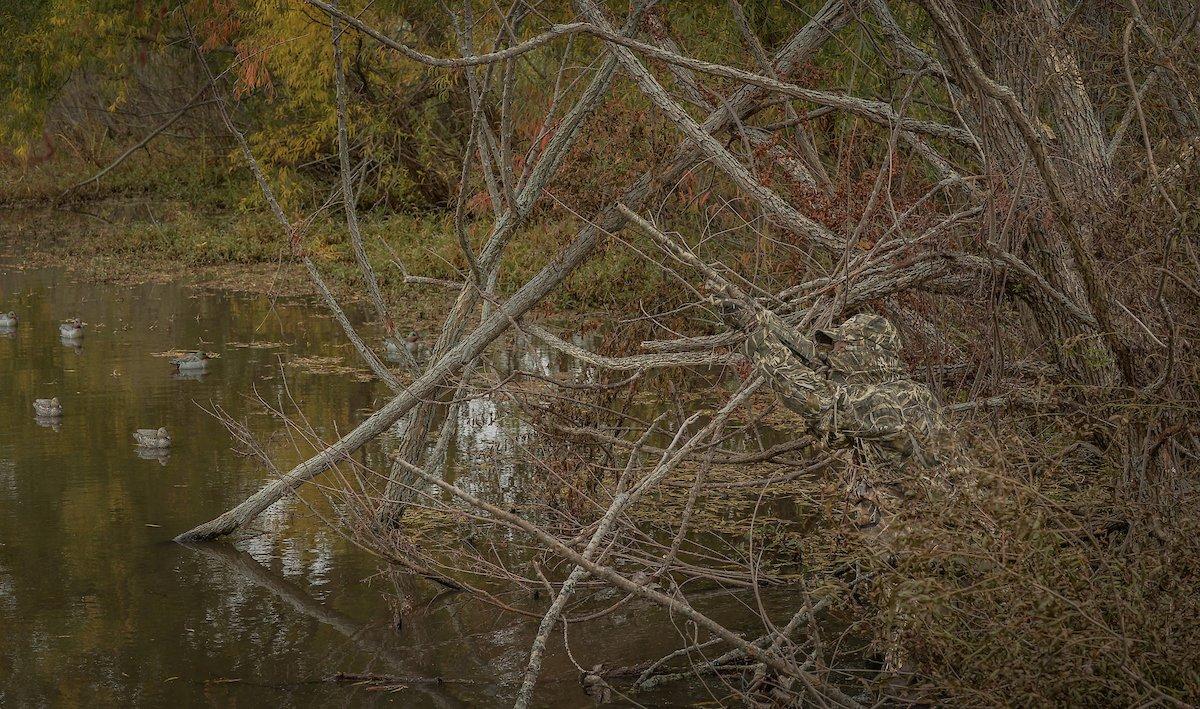Muck, Boats, Cover and Harsh Conditions Make Wing-Shooting Challenging
I love those classic duck and goose hunting shots. You watch the target come into range, rise with perfect form and footing and then follow through precisely, just like at the skeet range.
Thing is, you're not at the skeet range. Or the trap field. Or even a sporting clays course. Waterfowlers have to hunt the sloppy, spongy, slippery, uneven or even moving environs where ducks and geese live. As a result, hunters must often — maybe even usually — perform a seemingly endless variety of trick shots to consistently put birds in the boat or on the strap. Some of these are intuitive. Others can be comically difficult. Here's the heads-up on some of the weird (read: difficult) shooting scenarios you'll experience in the duck marsh.
The False Floor
Anyone who's shot ducks from a skiff or canoe knows those small crafts are unstable. Heck, even if you drag your boat into the thick stuff, it'll still move, ensuring you'll be somewhat unbalanced while shooting.
Solution: Make your craft as stable as possible. Beach it atop a bog. Wedge it between stout vegetation. Sink metal poles or closet rods — whether through attachments or built-in channels — into the mud to prevent the boat from rocking. Also, practice standing and shooting before the action starts. Your brain and body will adjust somewhat to the less-than-stable platform.
Concrete Overshoes
Standing in shoreline muck or cattail bogs might seem preferable to shooting from a shaky canoe, but it leads to another problem: Specifically, your feet often sink deep into the mud, preventing you from turning or swinging naturally.
Solution: Find the hardest, most stable bottom possible. Maybe it's a sunken cattail bog. Perhaps it's a stretch of sand or gravel amid shoreline muck. Where legal, sink a pallet or similar platform to facilitate better footing.
The Lying Game
Shooting from a field blind or layout boat isn't that difficult, but you must become accustomed to performing a quick sit-up while simultaneously swinging on a bird. Some folks catch on immediately. Others require some time.
Solution: Practice the motion at home. Learn how to position your legs, hands and gun in a blind or boat so you can unconsciously rise, swing and shoot.
The Unfamiliar Country
Everyone builds blinds differently, and your buddy's idea of the perfect hide might hinder your sight and shooting. Unfamiliar blinds goof me up more than anything, but I like hunting with other folks, so I try to adapt.
Solution: Analyze the situation before shooting light. Determine how to sit so you can see birds, and position your gun so you can grab it, stand and swing without bumping into stuff or hitting your head on the roof. You should be fine after a few practice takes.
Ducking Cover
This relates to item No. 3. Sometimes, you must push blind doors or cover flaps open before or as you rise to shoot. And that extra effort often costs time and affects the pre-mount/mount motion.
Solution: Again, practice the motion before gunning begins. Focus on opening the flaps or doors quickly and precisely while readying for the shot. You'll be a pro in no time.
The Deep Squat
When using natural cover, you often have to kneel, crouch or sit on a small stool to hide your profile. Then, as birds arrive, you must stand quickly and shoot. This seems natural, but it sometimes frustrates folks, as you must shift your weight forward and smoothly bring your gun to your shoulder as you rise.
Solution: Many guys want to shoot while sitting. Don't. It doesn't work. Instead, try to position your feet beforehand to allow good form. If you're right-handed, point your left foot where you will likely shoot at the bird. Keep both feet at shoulder width, and focus on putting most of your weight on your left foot when you rise. When you call the shot, stand quickly and firmly while shouldering the gun. With practice, the motion becomes second nature.
No Love for Gloves
I'm picky, but I cannot stand using gloves on my shooting hand. I'd rather endure frozen fingers all day than have to fumble for the safety and trigger. Gun manufacturers have helped by offering waterfowling shotguns with larger triggerguards that facilitate easier shooting with gloves. Still, I can't do it.
Solution: Practice shooting with gloves to see it troubles you. If not, great. If so, incorporate other hand-warming methods (muffs, hand-warmers or a portable stove) into your hunting gear so you can leave your trigger hand bare and nimble.
Sun Versus Gun
You know the deal: Trying to shoot anything while staring at the brilliant rising sun does not work. The obvious solution is to avoid this and set up with the sun at your back or side, but you can't always do that. Ugh. Prepare for the glare.
Solution: Realize your predicament, and do your best to shoot at birds before they disappear into the sun. In fact, try to set your decoys to facilitate this. Sunglasses help, too. Sometimes, when field hunting or layout hunting, I'll use part of the blind or even my hand to shield my eyes from the glare and help me spot incomers sooner.
Click here for more Realtree waterfowl hunting content. And check us out on Facebook.







